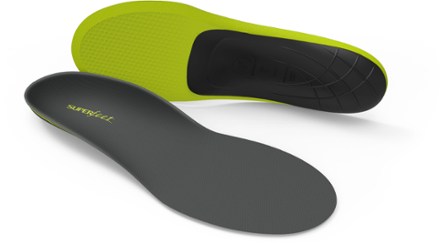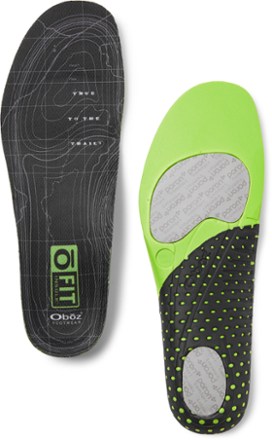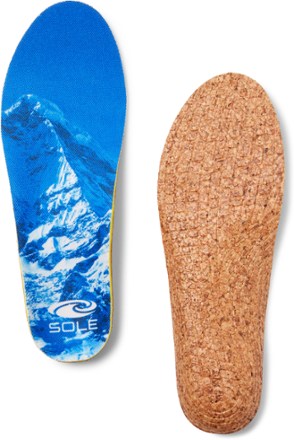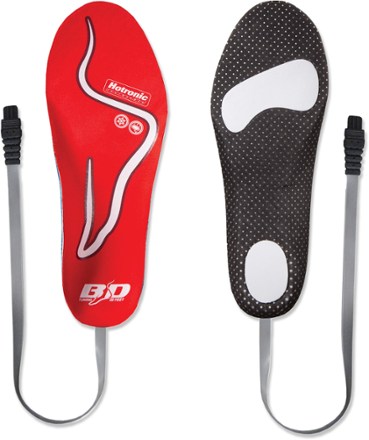
How To Choose
The Best Hiking Insoles For
Comfort, Stability & Support
By Diane Spicer
Let's examine in detail how a pair of the best hiking insoles can become a trusted part of your hiking gear.
Sore feet and hiking may go together in your experience, but it doesn't have to be that way!
Tips for alleviating sore feet after hiking are here... or stick with me here in this complete guide to using insoles to manage or prevent soreness during a hike.
It covers:
- what insoles are
- insoles versus orthotics
- who needs insoles
- which types of insoles work best for hikers
- how to choose the best hiking insoles for your feet
- care and cost savings tips
So what are insoles?
The name gives you a pretty good clue, right?
The heels, balls and toes of your feet contact the surface of the footwear you wear on the trail, be it hiking boots, trail runners, cross trainers or trail shoes.
- The shape and height of your sole determines how much, or how little, of the middle part of your foot makes contact with the insole section.
An insole is designed to be inserted into your footwear to help cushion your feet, acting as shock absorbent material for every footfall so you remain comfortable while you hike.
An insole can grip your foot more solidly, preventing movement, friction and hot spots that can lead to blister formation.
Wearing the best hiking insoles also helps evenly distribute your body weight and the weight of your backpack across the surface of your foot to prevent soreness.
In addition to these big jobs, you can expect the best hiking insoles to absorb the heat and sweat from your socks, directing it away from your skin and holding it in the insole material. This translates into cooler feet, and thus more comfort.
And it might even cut down on the stink associated with sweaty feet!
Sounds like finding a pair of the best hiking insoles might be a good idea, right?
Two types of insoles for hikers
Before we go any further, there's an important distinction to be made here when talking about insoles.
When you purchase a pair of hiking boots or other trail footwear, there are what are called "stock insoles" or "standard factory insoles" already in place.
Part of the price you're paying is for these insoles.
- Although in my 40+ years of buying hiking boots and trail shoes, not much attention is paid to this part.
What we're discussing on this page is something different, and it has two names, acknowledging the fact that you purchase them either in addition to, or after you wear, your footwear:
- aftermarket insoles
- shoe inserts
And as a hiker, you should be looking at those which are designed specifically as sport insoles, also called support insoles, to provide stability and structure for feet that work hard on the trail.
- Especially if you're a backpacker, bearing variable amounts of weight over long distances for long periods of time.
So now that you are up to speed on lingo to make sense of the somewhat confusing world of insoles, let's move on to the next question.
How are insoles
different from orthotics?
The key word is customization.
When you invest money in a doctor's appointment and fill a prescription for custom orthotics, you are going to end up with custom made shoe or boot inserts.
Some orthotics are focused on providing support and cushioning for people who have diagnosed medical conditions, such as diabetes. By using prescription inserts, they are able to retain mobility with less pain.
Other orthotics are designed for arch support and correction of gait problems. Long distance athletes, anyone with biomechanics issues which impact function, and hikers with injuries might want to investigate what orthotics offer.
Either way:
- Consult your health care provider if you are interested in custom made inserts.
- And expect to pay more for them than the insoles covered in this guide.
Now let's continue with our quest for the best hiking insoles by taking a look at hikers who could benefit from wearing them on a hike.
Maybe you'll spot yourself.
Who needs the best hiking insoles?
An argument could be made for everyone who walks!
After all, we all want feet that feel comfortable, cushioned and supported inside our daily shoes, as well as inside our boots or trail shoes, right?
And we want to keep taking step after step down the trail in order to reach our destination, without painful, burning, sore or tired feet.
But there are hikers who need to try a pair of the best hiking insoles for even more specific reasons.
Maybe you can relate to some of these hiking scenarios?
Hikers with
diagnosed foot problems
A podiatrist may have diagnosed your feet problems using this terminology:
- pronation (feet roll inward as you walk)
- supination (feet roll outward as you walk)
- plantar fasciitis (connective tissue on bottom of foot, called fascia, is torn)
- structural misalignment (bony tissue configuration causes stress as you walk)
- Morton's neuroma (painful toes and ball of foot due to nerve inflammation)
- hammer toe (abnormal joint alignment)
- bunion (severely misaligned joint on big toe)
If you've got a diagnosis, you're probably already dealing with sore feet after a hike, if not outright pain that keeps you off the trail.
Choosing the correct insole will prevent further problems, or can help you hike again.
Example:
Overpronation year after year as you accumulate hiking miles can flatten the arch of your foot, or even elongate it.
- As your foot makes more complete contact with your boot, and the ball of your foot in your socks moves back and forth with each step, thick layers of skin called calluses are created.
- Overpronation is also implicated in Morton's neuroma.
So in this example, a pair of insoles can be very helpful to prevent further trauma to your feet if you already know that you roll your feet inward as you walk.
Hikers with
self diagnosed foot issues
If you've been on this planet for awhile, you've learned to cope with biomechanical problems like high arches when you shop for shoes.
- Or low arches.
Let's get specific.
With every pair of footwear you purchased in the past, you had to deal with how the sole of your foot did, or did not, contact the insole. An unsupported arch means tired, sore feet.
You are probably also aware of any heel slippage problems, when the front and middle portion of your foot fills the shoe or boot, but your heel has too much room and is able to slip around with each step.
- That sets up a lot of friction and heat, and hot spots are soon to follow.
A pair of the best hiking insoles can work hard to bring your feet into proper alignment, disperse the weight they are bearing, and keep you comfortable.
And here's something to keep in mind: female feet and male feet are not alike.
We'll look at unisex versus gender specific insoles in a bit.
Hikers with
ambitious mileage plans
If you've set yourself a huge hiking goal such as finishing the Pacific Crest Trail in one go, wearing the right pair of hiking insoles can enhance your athletic performance.
In other words, because your feet are going to take a pounding as a thruhiker, anything you can do to optimize your performance day after day will be important.
Insoles might give you just enough edge to keep trudging onward, with your feet not at the top of your "it hurts" list.
Wearing insoles might will also rob you of a thruhike or section hike souvenir like permanent foot problems (see sobering list above), something I know you can live happily without!
Hikers who prefer
lightweight footwear
These days, trail shoes and even hiking boots are made of softer, less sturdy but more flexible material.
For example, the cushioning and support in lightweight trail running or cross training shoes may not be adequate for your feet when you're going for the long haul while bearing the weight of a backpack.
Purchasing a pair of aftermarket insoles which are designed for hiking feet inside a specific choice of lightweight footwear will give you maximum stability, support and comfort while you reap the benefits of lighter feet.
Older hikers who are
beginning to notice changes
I happen to be in this category, and I'll bet I'm not alone.
After a hike of double digit mileage with some decent elevation gain, my feet are sore, sometimes into the next day or two.
And I can always gauge when I hit the ten mile mark during a hike, because the bottoms of my feet start to send me insistent messages, like "when are we going to be done here?"
And my arches begin to ache with each foot fall and push off motion, making it hard to concentrate on the beautiful trail.
Part of this is because aging feet lose their fat pads, making each step more jarring to tendons, ligaments, nerves and other soft tissues on the bottoms of our feet.
- Hikers with high arches face a higher probability of this occurring, as more stress is placed on the heel as well as the front of the foot with each step - exactly where those fat pads are located.
- See? Sometimes fat is helpful!
So if you can relate to achy feet as a hiker of a certain age, maybe it's time to provide those hard working feet some extra love in the form of cushioned, supportive hiking insoles.
Winter hikers with cold feet
need the best hiking insoles
for comfort and safety
Did you know that you can use heated insoles in your winter hiking boots to keep your feet warmer?
This option keeps you safer as well as more comfortable on those short, cold days of winter - you don't need to worry about losing sensation in your feet.
Now let's focus on a strategy for how to look for the best hiking insoles for your unique feet, shall we?
We'll start with insole volume.
Insole volume and
hiking sock thickness varies
Don't let the word "volume" throw you if you're having traumatic high school geometry flashbacks. (Just me?)
Here, it refers to how much room the insole takes up inside a shoe or boot.
It also gives a nod to the shape of your arch, which we noted above as a biomechanical fact of life for your individual feet.
Here's the plain truth:
It's going to take a bit of experimentation to get the correct insole volume for your foot issues plus your choice of hiking socks.
So try on insoles with the socks you intend to wear on the trail. Socks + insoles are critical to making your final determination of the best hiking insoles for your feet..
- Don't have a favorite pair yet? Read these hiking sock selection tips.
What are the insole volume options?
A high-volume insole in a hiking boot can be perfect for a hiker with high arches.
Low-volume insoles can provide a supportive environment for hikers with extremely low arches, not by directly supporting the arch but by redistributing body weight across the foot and away from the arch.
Everyone else?
- Look at medium-volume insoles as a starting point. You're in that somewhat vague "normal" arch category.
Types of insoles for hikers
There are several many things to pay attention to when you're seeking the best hiking insoles to prevent or solve foot problems.
Let's make a list:
- the material used for the insoles, either semi-rigid or rigid
- the properties of the fabric: moisture absorption, anti-microbial top fabric, heat reduction, friction reduction
- availability of replaceable covers so you can keep the working part of the insole but replace dirty, torn or smelly outer fabrics
- the volume of the insoles, related to the shape of your arch and the width of your foot (see above)
- gender specific versus unisex
- the price point you're seeking
- the design: specific foot issues as outlined above, or a general purpose insole
- the guarantee or warranty provided by the insole company
- customer feedback and reviews
A few examples of insoles for hiking
These three examples are available at a company well respected by outdoorsy folks: REI Co-op.
Hiking For Her is an REI affiliate.
Clicking on the photos will take you to detailed descriptions and honest product reviews to help you select the best hiking insoles for your feet and preferred footwear.
It will also result in a small commission for HFH, but you pay nothing extra to support the flow of free hiking tips on this website.
Let's step through your volume options (see what happened there?).

|
Low volume, low profile, unisex, carbon fiber + lightweight foam insoles for hikers: Superfeet Support Insoles. Also available in other volumes and styles to fit all of your footwear, on or off trail. |
|
Medium volume, deep heel cup, unisex, high density EVA: Oboz O FIT Plus. This insole can be used with footwear brands other than Oboz.
|

|

|
SOLE Performance insoles: high volume (thick), moldable recycled cork base, unisex. Available in other volumes, too. |
How to select the
best hiking insoles for your feet
Now that you've got a solid idea of what an insole can do for you, and which type might offer the best features for your sore feet, it's time to select a pair.
And then take good care of them!
Here's how.
Work with a reputable insole company
to find the best hiking insoles
If your feet don't have diagnosed problems and you have normal arches, maybe a pair of inexpensive cushion insoles that you cut to fit your current boots will be enough to bring your feet a little more comfort and stability.
- Dr. Scholl's drugstore insoles comes to mind, like these.
However, if you've got feet that are anything other than textbook "normal" (and who doesn't?), it pays to head off trouble and to deal with the issues you currently have by selecting the best hiking insoles you can afford.
Uncomfortable feet = no hiking, so "afford" can mean many things beyond just money. Time investment, for example.
The insole examples above are all well known brands which hikers rely on (read the reviews).
Here's another:
Tread Labs is a company founded in 2015 by the guy who designed Chaco sandals, Mark Paigen.
- If you've been hiking for any length of time, you've heard of these iconic sandals!
Hiking For Her is a Tread Labs affiliate because of the quality medical grade insole designs, detailed product descriptions, and extensive customer support they offer.
Feet matter to a hiker, and this company takes feet seriously!
For example, there are 4 arch heights available to accommodate a wide range of foot contours.
And that's just for starters.
They offer a "find your fit" quiz to help you purchase exactly what you need for foot comfort.
A Hiking For Her Tread Labs hiking insole review for female hikers,
with more details about this direct-to-consumer company,
is available here.
Be sure the insoles fit well
When you step into a good pair of insoles, they will convey a feeling of support as your feet contact the inside surfaces.
But it's important to test exactly how much support you receive when the insole is outside of your boot or shoes, to assess how stable you feel when your foot is being cupped by the material.
Here's the best tip for shopping for the best hiking insoles:
- Be sure you're wearing the socks you intend to wear on the trail.
Put one insole on the floor and step into it with your sock encased foot, bringing your body weight to bear on it. Now the other insole...
If you're a purist, you're wearing a backpack loaded up with your usual amount of gear.
Ask yourself:
- How does each foot feel, both immediately and after a few minutes?
- Anything pressing or digging in?
- Does the heel cup feel deep enough for your foot?
- Or is it annoyingly deep and rubbing on the side of your foot?
Now it's time to put the insole into your boot/shoe to determine the level of support you feel, as well as how the insole interacts with the contours of your footwear.
You're keeping your mantra top of mind: comfort, support and stability.
Other things to look for as you test insoles:
- Your foot remains stable when you walk - no sliding around, despite your socks.
- Your arch is supported, but not being pressed on or pushed up.
- You have enough room in the toe box to wiggle your toes. This is important after a long hike when your feet have swollen a bit, so try to factor it in (mentally) right now.
Tip: Remember to remove the stock insole before you run this test, but keep it handy in case these insoles don't work out.
They're better than nothing while you're on your quest for the best hiking insoles for your feet.
Give them a fair test
Your feet are used to doing things their own way inside your boots.
Now you've introduced a brand new dynamic.
They might get a little miffed! And they might complain with a new set of aches and soreness.
So try out your insoles on a short hike, and build up to longer periods of time, before you chuck out the insoles and start over.
It takes a bit of time, body heat and weight to mold even the best hiking insoles (most expensive, highest quality materials, best design) to your contours.
How to care for your insoles
After going through all of that time, and investing some cash, it makes sense to take care of your insoles.
Think about what you force the insoles to do, and then do the opposite:
- They absorb your sweat and dirt, so air them out after every hike.
- They contact your dirty socks, which get dirtier the longer you're on the trail, so remove them after a hike and give them a quick brush off.
- They hang onto your grime and sweat by design, so take the insoles out of your footwear and wash them with a mild detergent, then air dry them, at regular intervals or after a backpacking trip.
Every time you remove the insoles for regular maintenance, give them a quick inspection.
- Are there signs of wear and tear?
- Is the fabric covering the insole torn?
- Are they getting a bit too thin?
Time to replace them, just as you would for worn out boot laces, socks with holes in them, or any other hiking gear.
Although brands vary, it's asking a lot to expect any pair of insoles to last more than a year under heavy usage.
But if you're a day hiker who doesn't hit the trail every week, you'll get several years out of a pair of insoles with regular care.
Save money on your insoles
With Treadlabs (link above), you can replace just the fabric cover if the insoles themselves are still intact.
- Saves you some cash and space in the landfill, right?
If you have a Flex Spending or Health Spending Account, check the rules to see if you can use this money to purchase insoles for all of your footwear. Chances are you can!
Feet feeling any better?
On a hiking trail, sore feet can compromise your safety by slowing you down.
 Sore feet are no fun, no matter where you are.
Sore feet are no fun, no matter where you are.Or by making it hard to navigate the changing terrain, including water crossings that require balance and stability.
So pay attention to your sore feet before you develop chronic conditions like the ones noted above.
If you're already dealing with foot issues, do what you can to keep yourself on the trail.
- A great fitting pair of the best hiking insoles can go a long way (small hiking pun) toward making you a safer, more comfortable hiker.
Best Insoles For Hikers
|
I get emails all the time about what I wear, eat, carry and love to use on the trail. That's
why I provide affiliate links to you: the best gear that I use myself and have seen used by other hikers is instantly
available for your consideration, and the gear company sends a few
pennies per dollar to this reader-supported hiking website. There is no added cost to you! Everyone ends up a winner: Great gear for you, strong gear companies, and more free hiking tips for everyone. Thanks very much for your support. It's warmly and sincerely appreciated. It also helps send these hiking tips to all your virtual trail buddies around the globe. |
 |



